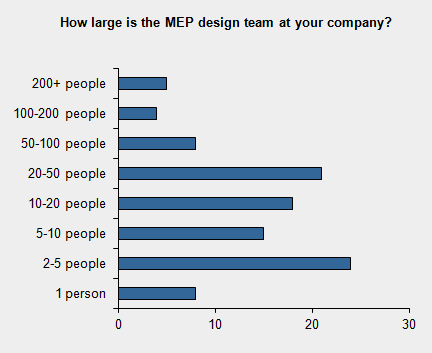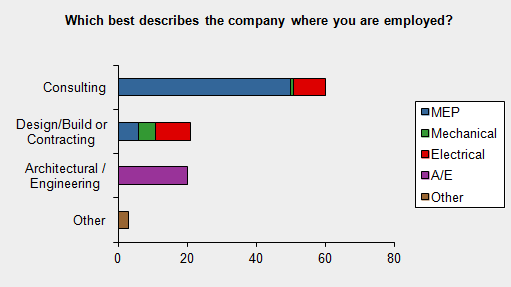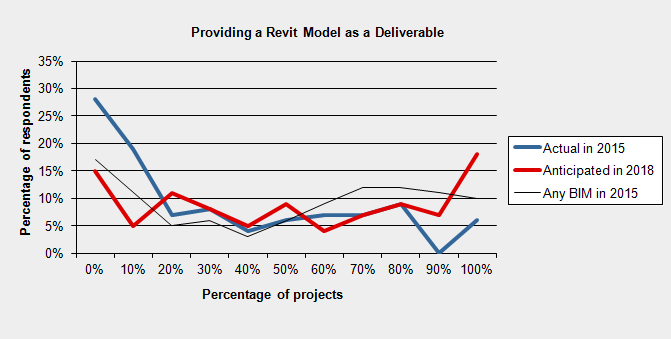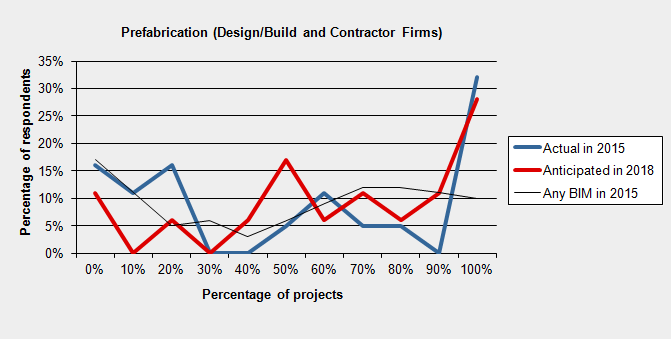This is the sixth year we have conducted our annual survey on the use of building information modeling (BIM) by engineers and designers in the MEP industry. Here is what we have learned:
- Use of BIM for 3D collision detection has not changed in 6 years.
- Expectations of use of BIM for 3D collision detection continue to exceed actual use.
- Expectations of increased use of BIM for 3D collision detection in the future have decreased slightly.
This year we expanded the survey to look at uses of BIM other than for 3D collision detection. With these results we have a snapshot of the current use of BIM. In future years we will be able to look at how the use of BIM is changing.
Complete results from the survey in 2010, 2011, 2012, 2013, and 2014 are available online.
Demographics
These results are based upon 104 respondents from the United States. The handful of respondents from outside the United States were filtered out of the results.
The following graphs show the size and types of the companies that respondents work at. Most of the respondents work at large companies. Most of the respondents work at consulting companies.



Different Ways BIM is Used
The first result we will look at is various ways BIM has been used on projects. We have been tracking four uses of BIM since the start of our survey: 3D collision detection, automated design, material takeoffs, and green design. We also have been tracking companies that do not use BIM at all.
In previous years, we asked, “Select all the ways your company uses BIM on projects.” We changed the wording of this question a little bit this year. We asked, “Select the percentage of your projects that you use BIM for this specific purpose on projects”. Using 0% from this year as “no” and anything else as “yes”, we were able to compare this year with other years.
There is a significant jump in the use of BIM for material takeoffs and green building design. This increase could indicate that BIM is being used for more purposes on projects. Since the question wording changed this year, we cannot say this definitively. It is a trend we will continue to follow in future years.

3D Collision Detection
The next result we will look at is the specific use of BIM for 3D collision detection. Each year we have asked what percentage of projects use BIM for 3D collision detection.
This first graph shows the current use of 3D collision detection for each year since 2010. The shape of the line is largely unchanged from year to year. The overall use of BIM for 3D collision detection has remained the same for the last six years.
(These graphs can be a little confusing at first. The x-axis is the answer the survey respondent gave to the question. The y-axis is the number of respondents who gave that answer. For example, at the far left of the graph, 22% of respondents use 3D collision detection on none of their projects in 2015. At the far right, 9% of respondents use 3D collision detection on all of their projects in 2015.)

The next graph shows the expected use of 3D collision detection in the future for each year since 2010. The percentage of respondents who thought all of their future projects would use BIM for 3D collision detection was around 30% for the first three years of the survey (2010-2012). In 2013, that value dropped to around 20% and has stayed at about that value. It appears that expectations were lowered in that year and have stayed lowered since.

The final graph compares the actual use of 3D collision detection in 2015 with what was anticipated three years ago in 2012. The actual use is less than what was anticipated. This result is the same as what we have seen the last two years.

Once again, we repeat this year the result we stated in 2013: far fewer projects today include 3D collision detection than people predicted 3 years ago. We expect the actual use of BIM for 3D collision detection to remain the same in the future. Either people will continue to overestimate it’s use in the future, or expectations will come down to match current use.
Other Uses of BIM
Next we have a snapshot of all the ways people are using BIM for MEP design this year. These questions are new, so we cannot compare them with previous years yet. For now these graphs can tell us where the industry currently is with the use of BIM. In future years we will be able to use them to know where the industry is going.
Any BIM On a Project: We intentionally did not define BIM for this question. It was left up to the respondent to decide what “BIM” meant and whether it applied to their projects.

Automate Design and Calculations: This use of BIM should not depend upon anyone else on the project using BIM. You can size a duct, a feeder conductor, or a pipe whether or not the architect or structural engineer provide you with their model. This use is one where every project could benefit from BIM.

Construction Documents: This use of BIM also should not depend upon anyone else on the project using BIM. Having a model from the architect should help, but it is not necessary. This use is also one where every project could benefit from BIM. Interestingly, the use of this type of BIM exceeds the use of any type of BIM on projects!

Material Takeoffs: To use a material takeoff or cost estimate, you typically need to be doing the design and the construction. When these tasks are separated, companies are hesitant to share data out of fear of liability. Even when both tasks are performed by the same company, the model needs to be able to be created early enough in the process for this information to have any value.

This second graph looks at use of material takeoffs and cost estimating by design/build firms and contractors. There were only 21 of them in the survey so it is a small sample. Comparing this graph with the one above it, you can see that design/build firms and contractors use BIM for material takeoffs more than the average firm in the industry.

Green Building Design: Green building design is a hot topic, but not a very common use for BIM. A lot of green design is about design choices (daylighting of rooms or choice of mechanical equipment) that BIM cannot help the engineer with. Once the choice is made, BIM can be used to model it, but there is no magic “make my building green” button.

Revit Model: Revit is a specific implementation of BIM. It is often requested by specific companies and government agencies as a final deliverable for a project.

Simulation and Animation: This category was added because a few respondents mentioned it as a use in previous years. It does not appear to be very popular.

Prefabrication: This category was also mentioned by respondents in previous years. Overall, it is not very popular.

This second graph looks at use of prefabrication by design/build firms and contractors. Like material takeoffs, these companies use BIM in this more than the average firm in the industry.

Fees: Finally, we asked whether respondents charged more when asked to use BIM for these various purposes.

The Use of BIM is Not Changing
The number of projects that use BIM for 3D collision detection has not changed in six years. The use of 3D collision detection in the MEP industry is stable and will not change in the future. Projects that benefit from 3D collision detection are already using it. Projects that do not currently benefit from 3D collision detection will not start benefiting from it in the future.
Our hypothesis is that the other uses of BIM are also stable and will not change in the future. We think other uses of BIM are like 3D collision detection. BIM software is mature enough today that if BIM is going to help on a project, it is already being used on it. If BIM is not going to help today, it won’t help in the future. The use of BIM in three years will match the use of BIM today.
